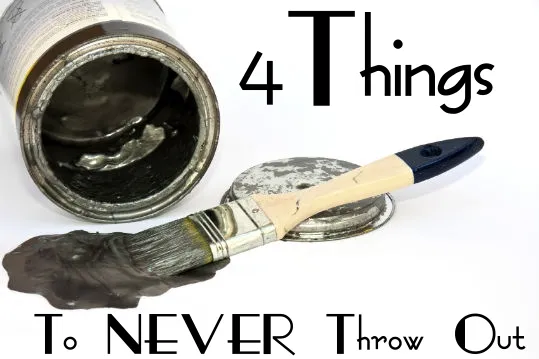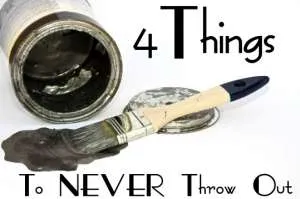
- Share on Facebook20
- Share on Pinterest
- Share on Twitter
It’s a given that the fewer things we pile up in our landfills, the better. There is no dispute about this. However, there are some things that are actually dangerous to toss in the garbage. One of the primary examples is leftover paint.
So, what’s wrong with throwing out leftover paint? Short answer: some types have the potential to cause significant harm to the environment, to wildlife, and to us, if they enter the soil or water. The US Environmental Protection Agency (EPA) estimated in 2007 that between 65 and 69 million gallons of paint are thrown away in the United States each year.
According to the EPA:
“Leftover architectural paint is a concern to communities across the country because of its high volume in the waste stream, resulting waste management costs, and potential for reduction, recovery, reuse and recycling. Leftover paint can also contain volatile organic compounds, fungicides and, in the case of very old paint, significant quantities of hazardous metals such as mercury and lead.”
The EPA adds:
“Of all HHW [household hazardous waste], paint is the single most voluminous and expensive material that many local governments collect and manage.”
Along with leftover paint, other paint-related substances, including strippers and paint thinners, are often made with hazardous compounds.
If you’re planning a home improvement or decor project in the near future, here are some tips on the best and worst types of paint to use, and how to deal with excess paint safely:
Your best bet is to find a source of organic paint: one that does not emit volatile organic compounds (VOCs). You may have to search a bit, but there are multiple sources online. Be sure to ask the manufacturer about safe ways to dispose of the type of paint you are using.
 The worst type of paint you can use is oil-based paint, which may be indicated by the word “alkyd” on the label. Oil-based paints are considered to be household hazardous waste (HHW) by the EPA, as their varnish, enamel, lacquer, and shellac compounds often contain hazardous chemicals. Very old paints (made before 1972) may contain lead.
The worst type of paint you can use is oil-based paint, which may be indicated by the word “alkyd” on the label. Oil-based paints are considered to be household hazardous waste (HHW) by the EPA, as their varnish, enamel, lacquer, and shellac compounds often contain hazardous chemicals. Very old paints (made before 1972) may contain lead.
It is best not to use these paints, but if you do, always dispose of them at a HHW facility. Habitat for Humanity locations also often accept leftover paint for proper disposal.
Aerosol paints come with the same HHW risks as oil-based paint. Plus, they are a terror to our planet’s ozone layer. If you need to dispose of some, locate a HHW facility in your area, or call Habitat for Humanity.
Water-based and latex-based paints are generally considered to be a less toxic alternative, however, they are still made with industrial chemicals, and may emit some toxic compounds. Those manufactured before 1992 may contain mercury, so be especially cautious. The laws on disposing of these paints vary state by state, so check the rules for your state’s HHW policy. It is best to take them into a proper disposal center, just to be safe.
Usually, you can recycle empty metal paint cans, but be sure to check your county’s rules.
A few additional tips:
- Never, ever, EVER pour any type of paint into a body of water, down the drain, or into a storm drain. Likewise, never pour it out on the ground.
- Never attempt to burn paint. This can release harmful compounds into the air — and into your lungs.
- Buy only the amount of paint you need. If you do overestimate, try sharing leftovers with members of your community.
While we’re at it, the following are three things — other than paint — you should never, ever throw in the trash:
- Anything made of glass. Besides the fact that glass is recyclable, and has no place in a trash can anyway, shattered glass can seriously injure sanitation workers. In the case of glass light bulbs and thermometers, the situation is even more dire. Both of these contain mercury, and need to be disposed of at an HHW facility, or another appropriate facility in your area.
- Batteries. Batteries are rife with toxic chemicals that can leach into the environment, poisoning the soil and groundwater. This includes all types of batteries, big and small. Be sure to dispose of these at an HHW facility.
- Motor oil. Again, this contains toxic chemicals that are potentially harmful to both humans and the environment. Do not dump or throw away motor oil. You can usually dispose of old motor oil at an automobile service station, or an appropriate recycling center. Make sure to check the rules and return options in your area.
Happy painting!
-The Alternative Daily
Sources:
http://www.epa.gov/sectors/sectorinfo/sectorprofiles/paint.html
https://www.thealternativedaily.com/big-business-historically-backs-dangerous-ingredients-dont-buy-in
http://enlightenme.com/paint-disposal
http://www.huffingtonpost.com/2012/05/01/how-to-dispose-paint_n_1464518.html
http://www.livescience.com/13840-7-everyday-toxic-items-recycle.html
http://home.howstuffworks.com/home-improvement/home-diy/painting/how-to-dispose-of-paint1.htm
http://www.ecospaints.net/organic-paints.html
- Share on Facebook20
- Share on Pinterest
- Share on Twitter

